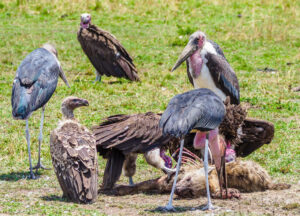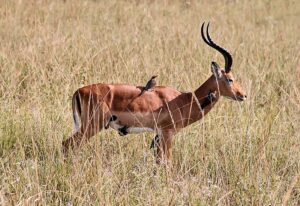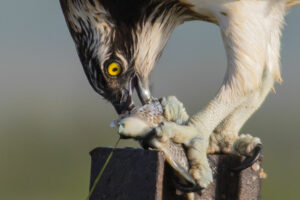In this post, you will find the different biota examples and their detailed explanations.
Biota is a self-sustaining unit made up of organisms from multiple distinct species that live together in the same region or habitat and interact through trophic and spatial relationships.
Each biota community shows interdependence of species. Some examples are:
- Neutralism
- Scavenging
- Commensalism
- Protocooperation
- Mutualism
- Amensalism
- Parasitism
- Competition
- Predation
- Soil Biota
- Pond Biota
- Producer
- Consumer
- Decomposers
Biota of the region are mainly divided into 3 major groups: Producers, Consumers and Decomposers. All the animals and plants that live in a particular region makes up the Biota.
Producers
Plants use sunlight energy to form organic compounds from inorganic substances like minerals, water and carbon dioxide with the help of chlorophyll.
Consumers
Carnivores animals feed on plants and other organism for obtaining the energy. They cannot make their own food and are also called heterotrophs.
Decomposers
The remains of dead plants and animals mixes with soil to form organic compounds. The carcasses of dead ones are further depleted by bacteria and fungi to convert them into simpler forms of organic and inorganic substances. Simpler forms are absorbed by decomposers itself and rest of all inorganic compounds are left in the soil for plants to reuse.

It contains two types of producers and three types of consumers.
Pond Biota
- Large plants : These plants grow on the edges of pond or floating in shallow water.
- Tiny plants: These plants are microscopic and generally free-floating on the surface of water. These microscopic plants are called the phytoplankton.
- Primary consumers: These include small crustaceans like cyclops and waterfleas that are herbivores. These small free-floating organisms are called zooplankton.
- Secondary consumers: They are carnivores and mainly feed on primary consumers. Examples are: Hydra,water insects, dragonfly, and small fishes.
- Tertiary consumers: They are also carnivores and feed on secondary consumers. Examples are large fishes, ducks and water fowls.

Each community comprises number of different populations of plants, animals and microorganisms which constitute its specific composition. Species composition depends on the size of area, diversity of habitats, soil type, altitude and also on abiotic factors.
One or few populations may exercise a major control over the structure of the community because of their size, numbers or activities. The species diversity depends on the size of the area a community occupies, diversity of habitats in this area, location , soil type, availability of water, climate and so forth.
Composition of Biotic community
A natural association of the interdependent populations of different species inhabiting a common environment or habitat is called a biotic community.
Biotic community consist of 3 components: plant, animal and microbial community.
- Plants prepare food from inorganic molecules to form organic substance with the help of chlorophyll by the process of Photosynthesis.
- The animals consume the organic food prepared by plants.
- The microorganisms consume dead animals and plants, as well as their products, converting them to inorganic compounds that are then reintroduced into the environment for plants to use as raw materials.
- All the populations in biotic community are interdependent and hence cannot survive separately.
- Plants are the producers and majority of them are autotrophs. Animals or consumers depend on the food prepared by plants.
- Birds and mammals help in dispersal of seeds and fruits of plants.
- Both plants and animals show interdependence with micro-organisms as well. Decomposers like Bacteria, fungus, and actinomycetes act as decomposers, breaking down dead plants and animals to liberate inorganic components that can be recycled in the environment.
Interactions in Biotic community
The interactions of organisms may involve only two or several species. The interaction can be beneficial, antagonistic and neutral.
Neutralism
Different species lives in a space without affecting each other.This lack of contact between species is referred to as neutralism. Example: Shrew, rat and rabbit live together in a grassland without affecting one another.
Scavenging
Those animals who feed on the remains of dead animals left by the other animal is known as scavenging. Example: Vultures feed on carcasses. Hyena and Jackals feed on remains of prey left by lions.

Commensalism
Two organisms interact with each other in which one is benefited and other one is unaffected or non-benefited. Example: A tropical fish Aeoliscus strigatus lives among the spines of sea urchin. The spines protect the fish from predators. Certain epiphytes grow on large plants in tropical rain forest utilizing only space.
Protocooperation
It is an association between individuals of two species, each of which is benefited by the presence of the other but can live equally well without association.
Example: Certain small birds sit on the cattle and feed on the latter’s parasites: lice and ticks. The crocodile bird enters the mouth of a crocodile to feed on the parasitic leeches. In both cases, both the partners can live equally well separated.
Mutualism
It’s a relationship between members of two species who benefit from each other but can’t exist apart in the wild. Example: Bacteria and ciliates get food and shelter by living in the ruminant stomach. Bacteria secretes the enzyme cellulase which helps the ruminants to digest their cellulose.

Amensalism
One organism is harmed by the other organism without getting benefit from the affected one. Generally, organism secretes toxins in their surrounding which damages the other organisms. Example: the bacterium, Streptomyces griseus, produces the antibiotic streptomycin which inhabits the growth of many bacteria.
Competition
Two or more organism compete together for resources that are limited having negative impact on each other.
Example: Tigers, lions and leopard compete for the same prey. Trees, shrubs and herbs in a forest to struggle for sunlight.
Parasitism
Generally, two organism of different sizes interact, in which one is small and other is large. Always the large organism serves as a host for the smaller one. The small one takes the nutrition from the host and make them suffer. The parasite is the creature that benefits while the host is the organism that suffers.
Example: Wuchereria bancrofti is a parasite that causes Elephantiasis in humans.

Predation
It is the interaction between two specie, one of which captures, destroys and eats up the other. Predator is the one who captures the prey. Without prey, the predator would perish.

Example: All carnivores that are not scavengers are predators. The relationship between snake and rat is more than that between owl and rat because snake also uses rat burrows as shelter.
Soil Biota
There are six main elements: carbon, oxygen, phosphorus, nitrogen, hydrogen and sulphur makes up the life. These elements are transformed by soil microbes through biogeochemcial cycles. Soil is another source of input of nutrients in an ecosystem. Nutrients present in soil are stored in various forms for the availability of plants. Bacteria, fungus, and actinomycetes are responsible for nutrient regeneration. Plants take a considerable amount of soil nutrients.
The simultaneous regeneration and absorption of nutrients in the soil maintains a dynamic condition of nutrients in the soil.
Summary
To wrap up the post, we would like to say that biota defines the interdependence of species in a particular region. They may be soil biota, water biota and including other living organism who are interdependent on each other directly or indirectly for the survival.
Also Read:
- Are algae protists
- Barnacle characteristics
- Do plant cells have a cell wall
- Exocytosis molecules movement
- Ribosomal rna function
- Dispersive dna replication
- Saturated fatty acid
- Do eukaryotic have enzymes
- Atp synthesis in aerobic respiration
- How is enzyme denatured

Hi, I am Saif Ali. I obtained my Master’s degree in Microbiology and have one year of research experience in water microbiology from National Institute of Hydrology, Roorkee. Antibiotic resistant microorganisms and soil bacteria, particularly PGPR, are my areas of interest and expertise. Currently, I’m focused on developing antibiotic alternatives. I’m always trying to discover new things from my surroundings. My goal is to provide readers with easy-to-understand microbiology articles.
If you have a bug, treat it with caution and avoid using antibiotics to combat SUPERBUGS.
Let’s connect via LinkedIn: